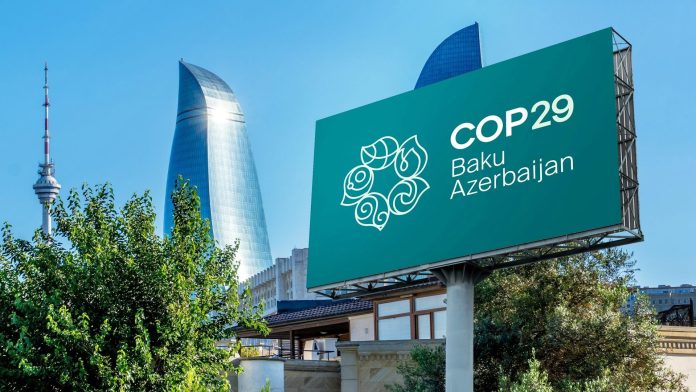Dr. Gyan Pathak
COP29 came out with a new draft finance deal on the last day of the summit on November 22, but it frustrated the stakeholders so much that they dubbed it a ‘slap on the face’. It had proposed $250 billion yearly, but left out specifics on how these funds will be raised, such as grants, loans, government sector, public sector, or private sector. Such a level of criticism triggered a closed door talks that overran the scheduled time throughout the night, and the sources say that the COP29 summit has raised the finance target to $300 billion per year by 2035.
The wealthy participants in the closed-door negotiations included the European Union, the United States, Australia, and Britain. Delegates of developing and least developed countries at the UN climate talks in Baku in Azerbaijan are still waiting for the final outcome yet to be communicated to them officially. There is also no official word yet from the Developed wealthy countries, and the matter seems requiring political call, as an observer has rightly said “the matter is now in the capitals of developed countries. They have to see how the New Collective Quantified Goal (NCQG) quantum can be raised. We are running a risk of the agenda of necessary level of funding to successfully deal with the climate crisis may spill over to COP30 in November 2025, which the host country Brazil’s presided Lula has said “will be our last chance to avoid an irreversible rupture in the climate system.”
COP29 is formally the 29th Conference of Partied to the UN Framework Convention on Climate Change (UNFCCC) dubbed by it as ‘climate finance COP’, since the parties were expected to establish a new global climate finance target called NCQG. It was the chief objective of COP29, since it was to replace $100 billion yearly target made in 2009 COP15, which expires at the end of the current year. It was another matter that the $100 billion target was met for the first time only in 2022.
Based on modelled projection using the United Nations Global Policy model, developing countries would need about $1.1 trillion in climate finance from 2025 and some 1.8 trillion by 2030. Climate experts have pegged the new annual funding goal at between $1 trillion and $1.3 trillion, which would assist vulnerable nations to deal with loss and damage from climate change and to adapt to that change, including building out their own clean-energy systems. The new draft outcome released on the last day of negotiations on November 22 had called for the overall climate financing goal to reach “at least $1.3 trillion by 2035 while leaving out specifics – how?
The text calling for $250 billion per year by 2035 was considered by delegates from developing and island countries too low and not consistent with delivery of the Paris Agreement.
Brazil’s environment minister Marian Silva has said, “We are proposing $300 billion at least from developed countries by 2030 an $390 billion by 2035 … as a form of kickstarting the process of achieving 1.3 trillion per year by 2030. The USA may leave the Paris Agreement. It increases our responsibility for COP30 also because a text like this will only result in further damage for humanity and the planet.”
The delegates at Baku were expecting – specifics about the role of developed countries in providing the new level of finance required to deal with the climate crisis, a global goal on a just transition, and a clear way forward on both adaptation and mitigation. The summit plenary is expected to reconvene also on November 23, 2024, ie the spillover of the conference for one day.
The new draft finance deal was severely criticized and Jacobo Ocharan of Climate Action Network International said the deal “terrible” while members from the civil society and environment advocates assembled in Baku expressed their anger and disappointment at the draft by taping pieces of paper on their faces or foreheads with “Pay up!” written on them. “It is a slap. It is an insult. … Rich countries are basically gambling with the lives of the people in developing nations and small islands,” Namrata Chowdhary from an international environmental organization 350.org said.
Nationally Determined Contributions (NDCs) commitments presently are far less than required to reduce the emission target set. UN Adaptation Gap Report 2024 released in October said that global emission would need to drop rapidly by 42 per cent by 2030 from 2019 levels. New NDCs are due in early 2025 by February in which countries will detail their intended climate actions through 2035. To achieve the goal of 1.5 degree Celsius, some 60 per cent of the world’s electricity would need to come from renewable sources by 2030. The world is not on track to this level of reducing emission and transition to renewable energy. Many countries on the other hand have made a target of increasing fossil fuel use for so called energy security for their people which will increase emission level. However, the fund to reduce emission, though increased, it would be a drop in the ocean, which activists said, “Not just a joke, but an insult”.
Nevertheless, the achievement of the COP29, will be increased climate finance and renewable energy commitments. It is frustrating that the summit declaration does not explicitly address the “phase out of fossil fuels”, climate funding, and implementation gaps. Issues are to spill over to COP30. (IPA)
Trending Now
E-Paper


